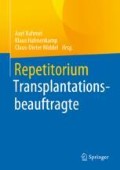Zusammenfassung
Die frühzeitige Identifizierung potentieller Organspenderinnen und -spender und deren konsequente und hochqualifizierte intensivmedizinische Versorgung bis hin zur Organentnahme ist sowohl logistisch, als auch medizinisch komplex und setzt ein hohes Engagement des Behandlungsteams voraus. Nicht immer ist der Gedanke an eine mögliche Organspende im klinischen Alltag präsent. Es ist Aufgabe der Transplantationsbeauftragten (TxB), Strategien zur frühzeitigen Identifizierung potentieller Organspenderinnen und -spender zu implementieren und eine anschließende optimierte Intensivtherapie zu unterstützen. Zur Unterstützung dieser Aufgabe stehen den TxB medizinische Bewertungssysteme und Entscheidungshilfen zur Verfügung (z. B. der FOUR-Score, DIVI-Positionspapier), aber auch organisatorische Maßnahmen (SOP-Entwicklung, Klinik-interne Fortbildungen, Einsatz des DSO-Tools TransplantCheck). Des Weiteren kann die DSO jederzeit hinzugezogen werden.
Access this chapter
Tax calculation will be finalised at checkout
Purchases are for personal use only
Literatur
Brauer M, Günther A, Pleul K et al (2019) [How many potential organ donors are there really? : Retrospective analysis of why determination of irreversible loss of brain function was not performed in deceased patients with relevant brain damage]. Der Anaesthesist 68:22–29. doi: https://doi.org/10.1007/s00101-018-0510-x
de Groot YJ, Jansen NE, Bakker J, Kuiper MA, Aerdts S, Maas AIR, Wijdicks EFM, van Leiden HA, Hoitsma AJ, Kremer B, Kompanje EJO (2010) Imminent brain death: point of departure for potential heart-beating organ donor recognition. Intensive Care Med 36:1488–1494
de Groot YJ, Wijdicks EFM, van der Jagt M, Bakker J, Lingsma HF, IJzermans JNM, Kompanje EJO (2011) Donor conversion rates depend on the assessment tools used in the evaluation of potential organ donors. Intensive Care Med 37:665–670
Fortbildungscurriculum „Transplantationsbeauftragter Arzt“ 1. Auflage, Mai 2015. https://www.bundesaerztekammer.de/fileadmin/user_upload/downloads/pdf-Ordner/Fortbildung/Curr-Transplantationsbeauftragter-Arzt.pdf. Zugegriffen: 4. Aug. 2020. (QR-Code 12.1)
Girlanda R (2016) Deceased organ donation for transplantation: challenges and opportunities. World J Transplant 6:451–510
Klassen DK, Edwards LB, Stewart DE, Glazier AK, Orlowski JP, Berg CL (2016) The OPTN deceased donor potential study: implications for policy and practice. Am J Transplant 16:1707–1714
Krankenhausentgeltgesetz vom 23. April 2002 (BGBl. I S. 1412, 1422)
Parvu V (2018) Entscheidungen bei potentiellen Organspendern. Gemeinsames Positionspapier der Sektionen Ethik und Organspende und -transplantation der DIVI 13.11.2015
Richtlinie gemäß § 16 Abs. 1S. 1 Nr. 3 TPG zur ärztlichen Beurteilung nach § 9a Abs. 2 Nr. 1TPG (RL BÄK Spendererkennung). Deutsches Ärzteblatt 2020: 1–12 https://doi.org/10.3238/arztebl.2020.rili_baek_spendererkennung_2020. Zugegriffen: 4. Aug. 2020
Schulte K, Borzikowsky C, Rahmel A, Kolibay F, Polze N, Fränkel P, Mikle S, Alders B, Kunzendorf U, Feldkamp T (2018) Decline in organ donation in Germany. Dtsch Arztebl Int 2018; 115: 463-8. DOI: https://doi.org/10.3238/arztebl.2018.0463
Smith M (2004) Physiologic changes during brain stem death—lessons for management of the organ donor. J Heart Lung Transplant 23:217-S222
Author information
Authors and Affiliations
Corresponding author
Editor information
Editors and Affiliations
Rights and permissions
Copyright information
© 2022 Springer-Verlag GmbH Deutschland, ein Teil von Springer Nature
About this chapter
Cite this chapter
Hahnenkamp, K., Kuhn, SO. (2022). Identifikation potenzieller Spender. In: Rahmel, A., Hahnenkamp, K., Middel, CD. (eds) Repetitorium Transplantationsbeauftragte. Springer, Berlin, Heidelberg. https://doi.org/10.1007/978-3-662-62614-6_12
Download citation
DOI: https://doi.org/10.1007/978-3-662-62614-6_12
Published:
Publisher Name: Springer, Berlin, Heidelberg
Print ISBN: 978-3-662-62613-9
Online ISBN: 978-3-662-62614-6
eBook Packages: Medicine (German Language)

